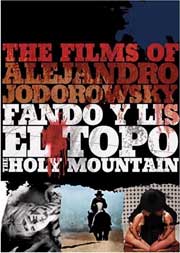 THE
FILMS OF ALEJANDRO JODOROWSKY: EL TOPO (1970)/THE HOLY MOUNTAIN (1973)/FANDO
AND LIS (1967)/LA CRAVATE (1957)
THE
FILMS OF ALEJANDRO JODOROWSKY: EL TOPO (1970)/THE HOLY MOUNTAIN (1973)/FANDO
AND LIS (1967)/LA CRAVATE (1957)Director: Alejandro Jodoworsky
ABKCO Films/Anchor Bay Entertainment
 THE
FILMS OF ALEJANDRO JODOROWSKY: EL TOPO (1970)/THE HOLY MOUNTAIN (1973)/FANDO
AND LIS (1967)/LA CRAVATE (1957)
THE
FILMS OF ALEJANDRO JODOROWSKY: EL TOPO (1970)/THE HOLY MOUNTAIN (1973)/FANDO
AND LIS (1967)/LA CRAVATE (1957)After a lengthy and very public battle with ABKCO/Apple executive Allen Klein over the profits and rights to his 1970s arthouse masterpieces EL TOPO and THE HOLY MOUNTAIN, director Alejandro Jodoworsky has finally made amends with Klein, resulting in this ultimate appreciation of the Mexican auteur! Gathered together in this boxed set are the two aforementioned cult classics, a re-release of his first feature-length film, FANDO AND LIS, and a previously unseen lost short, LA CRAVATE!
LA CRAVATE (THE
SEVERED HEADS) (1957)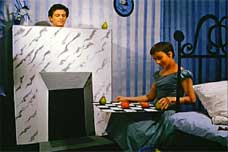
Adapted from a novel by Thomas Mann and apparently shot on a stage, this 20-minute short film was the first celluloid project undertaken by Alejandro Jodorowsky. Jodorowsky plays the lead, a nerdy man who visits a shop that sells human heads. The shop’s owner, a pixie-haired woman, removes his head and replaces it with that of a muscular boxer, leaving the nerd’s head sitting on her fireplace mantel. It’s rather hard to follow without dialogue and a restricted location, and at times looks like something Kenneth Anger would have made. The entire film is shot in mime, with musical accompaniment, drawing upon Jodorowsky’s background in performance art, and is actually a cute and funny little experiment for the budding filmmaker. Transferred from the sole remaining print, found in a German attic in 2006, the film’s colors look great and the musical score a tad muffled, but clear.
FANDO & LIS (1967)
 Jodorowsky’s
first feature film FANDO AND LIS was greeted with widespread controversy upon
its theatrical debut at the Acapulco Film Festival; it was subsequently banned
in Mexico and Jodorowsky was almost exiled from the country! Forty years later,
one has to wonder what all the fuss was about. Adapted from a surrealist theatrical
play by performance artist Fernando Arrabal (which Jodorowsky staged a performance
of during his time as a stage director), this is an interesting curio that shows
a tad of the visionary Jodorowsky would become, but is ultimately only half-successful.
Jodorowsky’s
first feature film FANDO AND LIS was greeted with widespread controversy upon
its theatrical debut at the Acapulco Film Festival; it was subsequently banned
in Mexico and Jodorowsky was almost exiled from the country! Forty years later,
one has to wonder what all the fuss was about. Adapted from a surrealist theatrical
play by performance artist Fernando Arrabal (which Jodorowsky staged a performance
of during his time as a stage director), this is an interesting curio that shows
a tad of the visionary Jodorowsky would become, but is ultimately only half-successful.

The threadbare plot follows the journey of Fando and his paralyzed girlfriend, Lis, through a barren desert landscape, in search of the mystical kingdom of Tar. Along the way, they flash back to moments in their childhood and encounter unusual people, including a troupe of transvestites, sexually insatiable mud people, a jazz pianist playing a burning piano, giggling temptresses in a junkyard, and various religious zealots. There is a certain fairy tale quality to FANDO AND LIS that keeps it interesting for a while, namely in the form of the idealistic romance between the title characters. The theme of the film is revealed as being innocence lost, as the two lovers are forced to face reality and come to terms with their fantasy crumbling. It’s a unique film, that’s for sure, but it’s difficult to enjoy or even like. The reason why FANDO AND LIS doesn’t necessarily endure as a classic Jodorowsky film is that it’s a little too experimental. Perhaps that sounds redundant, but whereas EL TOPO, HOLY MOUNTAIN and SANTA SANGRE are very personal films exposing the director and his personal philosophies, fetishes, and beliefs, FANDO AND LIS is culled from someone else’s work and finds Jodorowsky stumbling to find his way as a filmmaker. He doesn’t have the firm grasp of visual poetry that he would develop with his next film, EL TOPO, and relies a little too much on his Panic Theater background in terms of blocking and storytelling. Some viewers may note that with this film, Jodorowsky would begin his fascination with handicapped characters being carried by other characters, and his recurrent themes of fantasy vs. reality are present in full force. In the end, FANDO AND LIS is an important piece of the Jodorowsky puzzle, but is not a classic that can stand alongside the director’s best work.
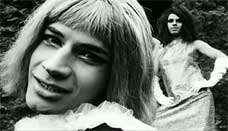 The
black and white 1.66:1 transfer for FANDO AND LIS is decent enough, but suffers
from PAL-to-NTSC formatting, resulting in unusual motion defects whenever the
camera moves. In some scenes, it’s almost impossible to watch because
of the transfer problem! The Spanish language track (with optional English subtitles)
is a bit scratchy, thanks to the very primitive shooting conditions.
The
black and white 1.66:1 transfer for FANDO AND LIS is decent enough, but suffers
from PAL-to-NTSC formatting, resulting in unusual motion defects whenever the
camera moves. In some scenes, it’s almost impossible to watch because
of the transfer problem! The Spanish language track (with optional English subtitles)
is a bit scratchy, thanks to the very primitive shooting conditions.
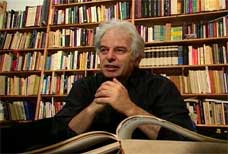
Most of the extras are ported over from the out of print Fantoma disc. Jodorowsky contributes an English-language commentary track, which is a little dry at times, but is still interesting as he talks about his intentions with the film and the trials of shooting his first film and its subsequent violent reception in theaters. A photo gallery includes behind-the-scenes snapshots and newspaper articles covering the film. The meatiest supplement is the feature-length documentary, “La Constellation Jodorowsky”. Clocking in at 83 minutes, this excellent French documentary covers Jodorowsky’s entire career, from his youth in Chile and his mime and Panic Theater beginnings and into all of his major films, including the very troubled RAINBOW THIEF. Interviews with mime extraordinaire Marcelle Marceau, former Genesis front man Peter Gabriel, playwright Fernando Arrabal, artist Jean Giraud flesh out his influence on the people he met and future generations of artists with his work. You get a peek at his massive home library, watch Jodorowsky drawing and writing at his desk, rare video clips of his theatrical performances in the Panic Theater (where future horror director Juan Lopez Moctezuma also got his start!), reading tarot cards, and speaking and performing in front of students.
EL TOPO (1970)
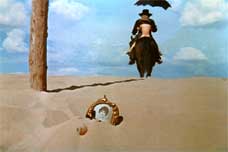 Wandering
the countryside of Mexico is El Topo, a gunslinger clad in black with his nude
seven-year-old son riding with him. The pair discovers the scene of a bloody
massacre, and seeks vengeance on behalf of the butchered men, women, children,
and animals. Once El Topo has destroyed the egomaniacal General responsible,
he rides into the blue yonder with Mara, a mysterious blonde woman who coaxes
him into seeking out and killing four gun masters in a vast desert. Through
his encounters with each successive master, El Topo comes closer to understanding
the purpose of his existence on Earth. A cruel twist of fate leaves El Topo
broken and weary, but his destiny calls in the form of an underground culture
that recruits him as its leader in a quest to reunite with a vicious desert
town.
Wandering
the countryside of Mexico is El Topo, a gunslinger clad in black with his nude
seven-year-old son riding with him. The pair discovers the scene of a bloody
massacre, and seeks vengeance on behalf of the butchered men, women, children,
and animals. Once El Topo has destroyed the egomaniacal General responsible,
he rides into the blue yonder with Mara, a mysterious blonde woman who coaxes
him into seeking out and killing four gun masters in a vast desert. Through
his encounters with each successive master, El Topo comes closer to understanding
the purpose of his existence on Earth. A cruel twist of fate leaves El Topo
broken and weary, but his destiny calls in the form of an underground culture
that recruits him as its leader in a quest to reunite with a vicious desert
town.
EL TOPO is essentially three films in one: a bloody revenge story, a mystical journey in search of life’s answers, and a tale of redemption in the face of a repulsive society and a damaged family member. On first viewing, it may be a tough film to warm up to. The first 30 minutes introduce a visually stunning and brutally violent western, but this facade is quickly ripped off to expose a spiritual core with layers more beautifully revealed in repeat viewings. 1970s audiences enjoyed smoking pot or dropping acid to fully “experience” the film, but it still works well as a hypnotic masterpiece without the aid of illegal drugs. The film’s dreamlike state is undoubtedly inspired by the fact that Jodorowsky envisioned most of his script through dreams he actually experienced; in another autobiographical touch, he plays El Topo himself. A disjointed narrative is pieced together with bizarre visual tableaus: El Topo’s son is completely nude as he clings to his father on horseback; the father-son duo walk through a small village littered with butchered corpses, hanged men, and filled with rivers of blood; a blind guru gun master is assisted by a pair of men, one with no legs who sits astride a man with no arms (shades of CRIPPLED MASTERS); El Topo blows up a balloon and allows the air to eerily escape as a countdown to a shootout; a house of elderly prostitutes assault a black slave boy, but cry rape and have him strung up and shot; a small town’s church congregation worships an eye-in-a-pyramid symbol and play Russian roulette, shouting “It’s a miracle!” when a lucky person shoots an empty barrel. Jodorowsky is obsessed with the color red, in pools, on clothing, in the least suspected places, possibly symbolizing his lust for life (in the form of blood). It also may be revealing much of Jodorowsky’s personal viewpoints on women that Mara is at various times throughout the film a dumb subservient slave, a scheming harpy hungering for power, a self-involved narcissist, and an easily seduced lemming. As noted before, this is a film that speaks volumes about its maker and his personal feelings on religion, gender, masculinity, social mores, the bourgeoisie, and other hot issues, and the more I think about and view EL TOPO, the more revolutionary and brilliant it becomes. It’s a challenging film, that’s for sure, but is stylish and bizarre enough to keep even those not interested in piecing it together watching with mouths agape.
 As
this is EL TOPO’s U.S. home video debut, there is really no competition
in the transfer department. Utilizing the original full frame negative, EL TOPO
bursts forth with bold color schemes and a crystal clarity that surely puts
all other versions to shame. Only a few lines here and there, and a handful
of color flashes, reveal the film’s age. You have two Spanish language
options (5.1 Surround or 2.0 Stereo) an English dub track to choose from; my
preference is for the 5.1 Spanish track.
As
this is EL TOPO’s U.S. home video debut, there is really no competition
in the transfer department. Utilizing the original full frame negative, EL TOPO
bursts forth with bold color schemes and a crystal clarity that surely puts
all other versions to shame. Only a few lines here and there, and a handful
of color flashes, reveal the film’s age. You have two Spanish language
options (5.1 Surround or 2.0 Stereo) an English dub track to choose from; my
preference is for the 5.1 Spanish track.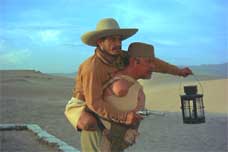
On an excellent feature-length audio commentary (in Spanish with English subtitles), Jodorowsky discusses his varied influences for the film, his beliefs in visual storytelling, personal philosophies on religion, the female gender, and other hot topics, the many symbolic and important images and scenes in the film, and memories of the cast and crew. It’s a perfect companion for the feature, providing answers to some glaring questions and allowing for a more in-depth appreciation of Jodorowsky’s work. However, an English video interview with Jodorowsky is pretty terrible thanks to the Editing 101 technique of flashing on-screen text of what Jodorowsky is saying. Skip it. The original U.S. trailer describes seeing the film as “an experience” (an understatement to be sure), and a photo gallery includes the original script and many behind-the-scenes photos and publicity stills.
THE HOLY MOUNTAIN (1973)
 Following
up EL TOPO, Jodorowsky decided to take the mystical aspects of his previous
work and his recent introduction to LSD to create a kaleidoscope of unorthodox
and striking images in the shape of a film. All right, let’s see if I
can summarize HOLY MOUNTAIN: a Christ-like figure wanders a strange landscape
populated by whores and charlatans before ascending via a giant gold hook into
a large red tower, where an Alchemist transforms his sweat, urine and shit into
gold. The Alchemist then proceeds to enlighten the man by introducing him to
seven powerful individuals, each named after a planet, who take great part in
the political system of the world. They all gather in the Alchemist’s
tower, burn their money, and join together on a quest to the Holy Mountain to
become immortal.
Following
up EL TOPO, Jodorowsky decided to take the mystical aspects of his previous
work and his recent introduction to LSD to create a kaleidoscope of unorthodox
and striking images in the shape of a film. All right, let’s see if I
can summarize HOLY MOUNTAIN: a Christ-like figure wanders a strange landscape
populated by whores and charlatans before ascending via a giant gold hook into
a large red tower, where an Alchemist transforms his sweat, urine and shit into
gold. The Alchemist then proceeds to enlighten the man by introducing him to
seven powerful individuals, each named after a planet, who take great part in
the political system of the world. They all gather in the Alchemist’s
tower, burn their money, and join together on a quest to the Holy Mountain to
become immortal.
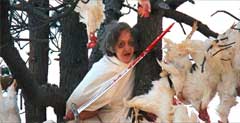
Even more hypnotic and symbolic than EL TOPO, HOLY MOUNTAIN is a visual mindfuck, an acid trip on celluloid, with Jodorowsky’s personal views on religion, war, values of society, and politics thrown into the mix. It’s surely one of the most unpredictable and warped experiences many people, me included, will have watching a film. Taking a similar approach to free-form cinema storytelling as Fellini and Bunuel, Jodorowsky opens the film with two blonde women having their heads shaved bald in a ritual resembling a Japanese tea ceremony. His hero is called simply “the Thief". He is crucified by a crowd of rowdy children who stone him, awakening him and sending him on his journey with a cackling midget with no arms as his companion. As the Thief wanders through a village, he sees soldiers marching through the streets with bloody dog carcasses crucified on sticks, a bloody all-toad re-enactment of the Spanish destruction of the Aztec society, men shot and birds flying out of their wounds, and a group of prostitutes, one with a chimpanzee, who become his apostles. The Thief’s existence begins to mirror Jesus Christ, as he is drugged and transformed by conmen into multiple Christ figures as false idols, which he destroys.
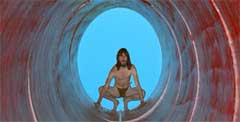 As
the Thief is educated in the ways of mysticism and alchemy, the extended focus
on seven corrupt individuals under the symbols of planets is actually the best
part of the film. Fon, under Venus, caters to narcissism, creating exterior
bicep, calf, crotch, and butt implants for the vain, life masks for people who
wish to be known for what they look like, not who they are, and vanity coffins
so the dead can kiss their family good-bye or put on burlesque shows! His father
makes all decisions by rubbing his dead wife’s vagina, indicating a ‘yes’
if it is wet, and he is surrounded by countless wives and children who work
in his factory. Isla, under Mars, is an arms manufacturer who creates chemical
warfare that incites delusions of grandeur or impressive rage, as well as psychedelic
counterculture guns, guitar shotguns, and pistols with symbols of Judaism, Christianity,
and Buddhism. Sel, under Saturn, works in the war department and trains children
to hate their Peruvian neighbors so they will become good soldiers when they
grow up; one of her tactics including publishing comic books about a superhero
fighting a Peruvian supervillain! Axon, under Neptune, is the chief of police,
asking his followers to have their testicles removed in a grand ceremony and
inciting police brutality in his city, in a brutal and inventive sequence.
As
the Thief is educated in the ways of mysticism and alchemy, the extended focus
on seven corrupt individuals under the symbols of planets is actually the best
part of the film. Fon, under Venus, caters to narcissism, creating exterior
bicep, calf, crotch, and butt implants for the vain, life masks for people who
wish to be known for what they look like, not who they are, and vanity coffins
so the dead can kiss their family good-bye or put on burlesque shows! His father
makes all decisions by rubbing his dead wife’s vagina, indicating a ‘yes’
if it is wet, and he is surrounded by countless wives and children who work
in his factory. Isla, under Mars, is an arms manufacturer who creates chemical
warfare that incites delusions of grandeur or impressive rage, as well as psychedelic
counterculture guns, guitar shotguns, and pistols with symbols of Judaism, Christianity,
and Buddhism. Sel, under Saturn, works in the war department and trains children
to hate their Peruvian neighbors so they will become good soldiers when they
grow up; one of her tactics including publishing comic books about a superhero
fighting a Peruvian supervillain! Axon, under Neptune, is the chief of police,
asking his followers to have their testicles removed in a grand ceremony and
inciting police brutality in his city, in a brutal and inventive sequence.
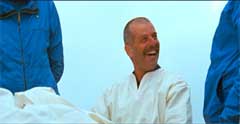
Jodorowsky plays the Alchemist himself, and this is important during the film’s climax, beautifully breaking cinema’s fourth wall. Let’s just say you won’t see this ending coming. After a lengthy sequence of the 7 training and becoming one with their minds, disposing of material goods and disconnecting from their body, the group ascends the mountain, experiencing their visions of death as a test of their willpower. A man sees himself nude, covered in tarantulas, screaming; a woman becomes sexually stimulated at the sight of two cows fucking, and is soon drenched in bull semen (!); a man beats drums wildly while two dogs actually fight each other violently; a nude man sees a terrifying old woman with a bloody sword atop a tree covered in bloody chickens, and in one swift motion, she castrates him! What a movie!! Like EL TOPO, this is a film that will reveal itself and its multiple layers with repeat viewings, and is a highly recommended experience!
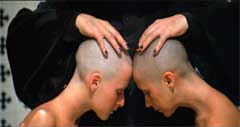
With such diverse and unusual color schemes and visual beauty, the 2.35:1 anamorphically enhanced transfer of HOLY MOUNTAIN is a sight to behold on its U.S. home video debut! The film looks as if it was shot yesterday, with no signs of print damage, debris, or other issues present. There are only two English audio options, 5.1 Surround or 2.0 Stereo, both of which are superb.
As with EL TOPO, Jodorowsky’s audio commentary on HOLY MOUNTAIN (in Spanish with English subtitles) is beautifully enlightening, as he speaks freely of his influences to make the film, the mental preparation he underwent before shooting, the various cast members, and most importantly, reveals the symbolic meaning of many important shots and scenes. He also goes into the controversy surrounding the film, including the Church speaking out against him and Mexican crew members and extras refusing to work any longer on the film. One particularly interesting story tells how George Harrison wanted to play ‘The Thief’, but refused to do one scene: the startling close-up of the Thief having his hairy anus washed by the Written Woman!! No interview with Jodorowsky appears on this disc, thankfully, but an informative featurette on his fascination with the Tarot and its meaning as a unit of cards in understanding life is included. A handful of deleted scenes are mostly boring training scenes of the 7 figures, though there is the death vision of the Written Woman which was for some reason was omitted; one scene was to be the basis for an alternate ending, where a woman actually gives birth on-camera, but the woman he hired backed out at the last minute. A restoration comparison shows just how wonderful the transfer looks compared to its previous incarnations! Another photo gallery contains script pages and behind-the-scenes snapshots, and the original theatrical trailer includes many of the most striking images in a great preview of this grand event (“Nothing in your education or experience can have prepared you for this film!”).
The remaining two discs of the collection contain the soundtracks for both EL TOPO and HOLY MOUNTAIN. Highly sought-after collector’s items, both scores aren’t exactly great listening material but are welcome additions to the set.
To be honest, THE FILMS OF ALEJANDRO JODOROWSKY as a whole isn’t an essential purchase; EL TOPO and HOLY MOUNTAIN are both available separately, and are the only two must-own films in the set. The primary reasons to buy this collection are for the previously lost short film LA CRAVATE and, if you’re a die-hard soundtrack collector, for the two soundtrack CD’s. But picking up EL TOPO and HOLY MOUNTAIN individually is a better, and more affordable, bet. (Casey Scott)